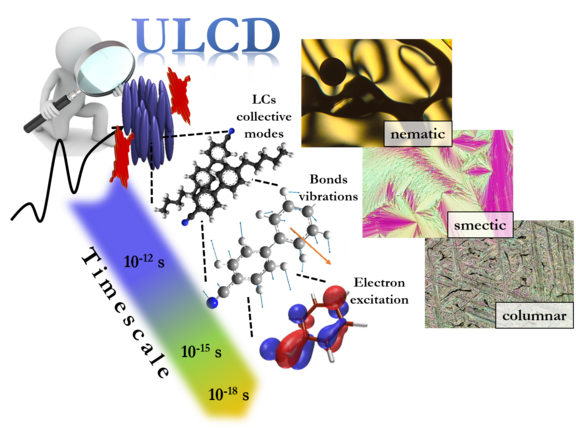Liquid crystals (LCs) are materials that occupy a unique state of matter—sitting between liquids and solids. These fascinating substances maintain some fluid-like properties while also exhibiting ordered structures that are characteristic of solids. Due to these remarkable features, LCs play a crucial role in many modern technologies, including liquid crystal displays (LCDs), tunable photonic devices, and adaptive materials. However, despite their widespread use, the fundamental dynamics at the microscopic level, particularly on ultrafast timescales, remain still unexplored.
At our research group, we’re focused on uncovering the ultrafast dynamics of liquid crystals, using advanced techniques like High Harmonic Generation (HHG) and Terahertz (THz) spectroscopy. These methods allow us to study the behavior of liquid crystals on timescales ranging from femtoseconds to attoseconds, providing a deeper understanding of how molecular and electronic processes evolve in response to external stimuli.
What Makes Liquid Crystals So Special?
Liquid crystals are composed of mesogens, molecules typically characterized by elongated or rod-like shapes, although some can also be disc-shaped. The shape of these molecules is crucial for their ability to align and form ordered structures. The unique arrangement and orientation of these molecules give liquid crystals their distinct anisotropic properties, meaning that their physical characteristics (such as refractive index, conductivity, and viscosity) vary depending on the direction in which they are measured.
Liquid crystals can exist in different mesophases, which are defined by the extent of both long-range orientational and positional order, describing how the molecules are structured:
Nematic Phase: In this phase, the molecules are aligned in the same direction (orientational order) but do not have any fixed positions relative to one another (no positional order). While they flow like a liquid, they maintain long-range orientational order.
Smectic Phase: In this phase, the molecules are aligned in a specific direction, similar to the nematic phase, but they also form layers, creating positional order within those layers. The molecules can slide past each other within a layer but cannot move freely between layers. Despite the ordering within each layer, the material still behaves like a liquid.
Cholesteric/Chiral Phase: In this phase, the molecules arrange themselves in a helical or twisted structure, with each successive layer of molecules slightly rotated relative to the next. This helical arrangement influences how light interacts with the material, resulting in unique optical properties.
Liquid crystals are highly sensitive to external stimuli. Their molecular alignment can be influenced by factors such as temperature, electric fields, and magnetic fields, which can trigger phase transitions. Our focus is on thermotropic liquid crystals, which transition between different phases in response to temperature changes. This responsiveness makes them particularly well-suited for control and display applications, such as in LCDs.

Insights into the dynamics of liquid crystals with HHG and THz spectroscopy
To investigate the ultrafast and collective dynamics of liquid crystals (LCs), we employ two complementary techniques: High Harmonic Generation (HHG) and Terahertz (THz) spectroscopy. HHG is a nonlinear optical process that allows us to probe molecular and electronic changes on femtosecond timescales by using a high-intensity laser that both excites and measures the LC response. This self-probing method reveals how energy is redistributed among vibrational modes and how electronic structures reorganize during phase transitions. On the other hand, THz spectroscopy focuses on low-frequency vibrational modes, enabling us to explore how collective molecular motions evolve as LCs transition from isotropic liquids to ordered phases. With THz pump–optical probe setups, we examine how these collective behaviors differ from single-molecule dynamics and investigate mechanisms behind refractive index changes, birefringence modulation, and resonant excitations in the 1–10 THz range. Together, these approaches provide a comprehensive understanding of the structural and electronic properties of LCs under dynamic conditions. Learn more about HHG and THz spectroscopy.
Towards Advanced Materials with Tunable Properties
The insights gained from these studies will help the community for designing next-generation materials that are highly controllable and capable of adjusting their properties in real-time, which is critical for emerging technologies in a variety of fields, from flexible electronics to adaptive optical devices.
In summary
Through the use of High Harmonic Generation and Terahertz spectroscopy, our research is uncovering the secrets of liquid crystals at an ultrafast level. By probing the molecular and electronic dynamics within these materials, we aim to push the boundaries of materials science and contribute to the creation of tunable, adaptive materials for next-generation technologies.
